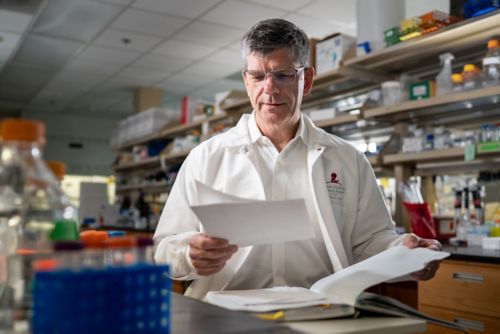St. Jude Family of Websites
Explore our cutting edge research, world-class patient care, career opportunities and more.
St. Jude Children's Research Hospital Home

- Fundraising
St. Jude Family of Websites
Explore our cutting edge research, world-class patient care, career opportunities and more.
St. Jude Children's Research Hospital Home

- Fundraising
When a stem cell divides, it retains information about how to grow, including instructions about what type of cell to become. Scientists at St. Jude gained a new understanding of how these processes can work. They revealed that subunits of the SWI/SNF chromatin-remodeling complex, which is mutated in 20% of all cancers, help cells remember their differentiation state during mitosis.
During differentiation, stem cells transform into a different cell type. Typically, the new cell type has a more specialized function, such as a skin or muscle cell. As cells divide, they must retain the “memory” of their differentiation state to transfer the proper identity to their daughter cells.
Chromatin is a complex of DNA and proteins tightly compacted inside cells. Chromatin must unwind to turn genes on and off in closely regulated epigenetic processes. SWI/SNF complexes facilitate the control of a cell’s identity during differentiation by recognizing histone marks to change chromatin architecture and regulate gene expression. These changes in chromatin architecture are maintained across cell divisions, but how this occurs has been uncertain.
Cancers often carry mutations that affect the SWI/SNF chromatin-remodeling complex. One example is the loss of the SWI/SNF subunit SMARCB1. Mutations in SWI/SNF subunits are also the basis of several neurodevelopmental disorders.

Research led by Charles W. M. Roberts, MD, PhD, Executive Vice President and St. Jude Comprehensive Cancer Center director, found a new role for the SWI/SNF chromatin remodeling complex.
In the current study, scientists at St. Jude discovered how subunits of SWI/SNF act as “bookmarks” during mitosis to preserve chromatin architecture and safeguard cell identity during division. The study, published in Nature, points to the importance of SWI/SNF core subunits SMARCE1 and SMARCB1 and their roles in the process.
“This work provides an understanding of a new component of mitotic memory clues to why a mutation of this SWI/SNF complex subunit would disrupt memory of what a cell should normally be doing and allow it to go into a cancerous state,” said senior author Charles W. M. Roberts, MD, PhD, Executive Vice President and St. Jude Comprehensive Cancer Center director.
Previously, researchers knew the enzymatically active subunit of the SWI/SNF complex was not bound to DNA during mitosis, so they assumed that SWI/SNF complexes had no role in that process. Surprisingly, Roberts’s team found that two individual SWI/SNF complex subunits, but not the rest of the complex, bind to mitotic DNA. They then showed that mitotic binding of SMARCE1 and SMARCB1 is required for the appropriate re-activation of bound genes after mitosis.
Experiments that removed SMARCE1 during mitosis showed that the loss of SMARCE1 impairs the ability of some other bookmarks to bind to their targets, disrupts gene expression, and causes abnormal neural differentiation. These findings demonstrate that SMARCE1 functions as a mitotic bookmark and is essential for retaining appropriate differentiation programming during mitosis.
“In adult cancers, where many genes are mutated, it is often challenging to figure out what any single mutation contributes. In rhabdoid tumor, we have a pediatric cancer apparently driven by just this one mutation,” Roberts added. “It’s a beautiful model to understand how these processes work and then begin to leverage that understanding for the myriad adult cancers that also have SWI/SNF mutations.”